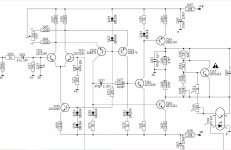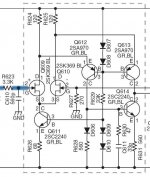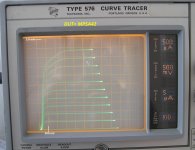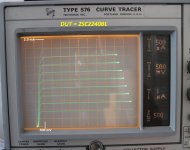How about we go start a forum for just CFA topology discussion and leave Doug Self to his own page here?
-RM
Ok that's a good idea.
I've opened a thread up.
Mods, you may want to move the CFA stuff to that thread.
Last edited:
How about we go start a forum for just CFA topology discussion and leave Doug Self to his own page here?
-RM
Hi Richard,
This sounds like a good idea. This CFA discussion has become quite interesting and fairly fast-moving.
Cheers,
Bob
...my CFA amp using 80dB loop @20k and more than 110dB loop @1k.
There is absolutely no way your amp. can have 80dB of loop gain at 20KHz and be stable. No way at all.
the CFA offshoot Thread is here
http://www.diyaudio.com/forums/solid-state/240712-cfa-topology-audio-amplifiers.html#post3593986
http://www.diyaudio.com/forums/solid-state/240712-cfa-topology-audio-amplifiers.html#post3593986
So... any comments on the 6th Edition?
Are there any supply problems? Some people's copies seem to have taken a long time to arrive.
Oh, this thread was about your book?
Got my copy super quick from amazon.com, have skimmed through it, looks good so far...
So... any comments on the 6th Edition?
Are there any supply problems? Some people's copies seem to have taken a long time to arrive.
No trouble with finding it nor obtaining the fine book you've put togther in a timely manner.
One area that is particularly informative that one doesnt find often enough -- practical info about implimentation details that can ruin a good design's potential. You dont find that sort of thing in a SIM... just takes experience and practice and testing.
-Richard Marsh
Last edited:
So... any comments on the 6th Edition?
Are there any supply problems? Some people's copies seem to have taken a long time to arrive.
Well seeing as I only had the 3rd edition before, I find the 6th a much more "readable" or lets say "enjoyably readable" read. The human touch is more in evidence. Not read it all word for word yet but have noticed such things as you mentioning using two small signal devices for the VAS, something I have been playing around with for some time before I saw it in print. That was a surprise. As an in depth "reference work" on the general amplifier design subject, it builds on what has gone before and its position, shared with one or two others of different approach is assured.
Doubtless there will be (or already have been) the comments on what isn't included... so maybe for the 7th edition
No book supply problems as such in that my copy arrived when Amazon predicted (a little before in fact) but it was galling to know it was available over 'tother side (no offence guys) and that we had to wait.
I received my copy of your in Monday. So I don't have any comment except this one.So... any comments on the 6th Edition?
Marantz use Folded-cascode configuration in his amps.
For example in PM7000 and also in his HDMA modules.
Attachments
So... any comments on the 6th Edition?
I wish the new material in chapter 7 had included a more thorough explanation of the problem with the MPSA42 at low Vce.
On p. 169 we read: The problem is that the MPSA42 requires an unusually high Vce to work properly.
Then on p.186: The MPSA42 appears to need considerably more Vce to work properly than the data sheet implies.
I wish you had included measurements of actual MPSA42 transistors, showing exactly how they are deficient. Perhaps something like the attached photos might have shed additional light on the situation. I marked Ice = 2.0 mA on the plots, since p.169 refers to Figure 7.4, in which the current mirror transistors operate at 2 milliamps apiece.
Apologies for the abysmal quality of the photos, including a reflection of the camera on the scopeface!
Attachments
So... any comments on the 6th Edition?
Are there any supply problems? Some people's copies seem to have taken a long time to arrive.
Hello Douglas,
I received my copy, and it was worth every penny, although I am inclined to think that it really ought to be out in hardback given its size; I wouldn't mind paying the premium.
In justifying the use of the acronym "VAS" on page 162 you aver:
This is false: the second stage in Thompson's topology does not provide all the voltage gain in the amplifier. On the contrary, it provides all the transimpedance gain in the amplifier.1. the VAS does provide all the voltage gain in the amplifier.
This justification is equally unconvincing because amplifiers are classified by their transfer functions and not by the quantities at their output.2. it is the first stage in the amplifier that has the full voltage swing at its output.
Therefore, the second stage in Thompson's arrangement is a transimpedance stage and not a "voltage amplifier stage" because it takes a current at its input and delivers a voltage at its output.
Further, you contend that using the term "transimpedance amplifier" would "mystify a lot of people". This is equally unconvincing as the vast majority of your readership are perfectly capable of making the distinction between a voltage amplifier and a transimpedance amplifier if said differentiation is competently explained.
See below:
http://www.diyaudio.com/forums/soli...lls-power-amplifier-book-416.html#post3583777
Additionally, on page 644, you state that input cascode inclusive compensation is due to B. K. Ahuja. It's not. It was, in fact, invented by Messrs Jolly and McCharles. See attachment.
Attachments
Last edited:
So... any comments on the 6th Edition?
I bought four editions from the six published.
It tells how much valuable information I am sure to find in them.
My sixth arrived at the begining of august a few days after having ordered it through Amazon-France.
The first time I opened it was at #188 and I immediately started to read paragraph "A Brief History of Cascode VAS".
You may be interested to know that an early usage of a cascode VAS was in amplifiers ZD50 and ZD100 of the RADFORD "Zero Distorsion Range".
Technical instructions including schematics are available here : ZD100 | Radford Revival
The output stage was also innovative, it's a precursor of the diamond followers (the predriver of the negative branch is shown with wrong polarity) :
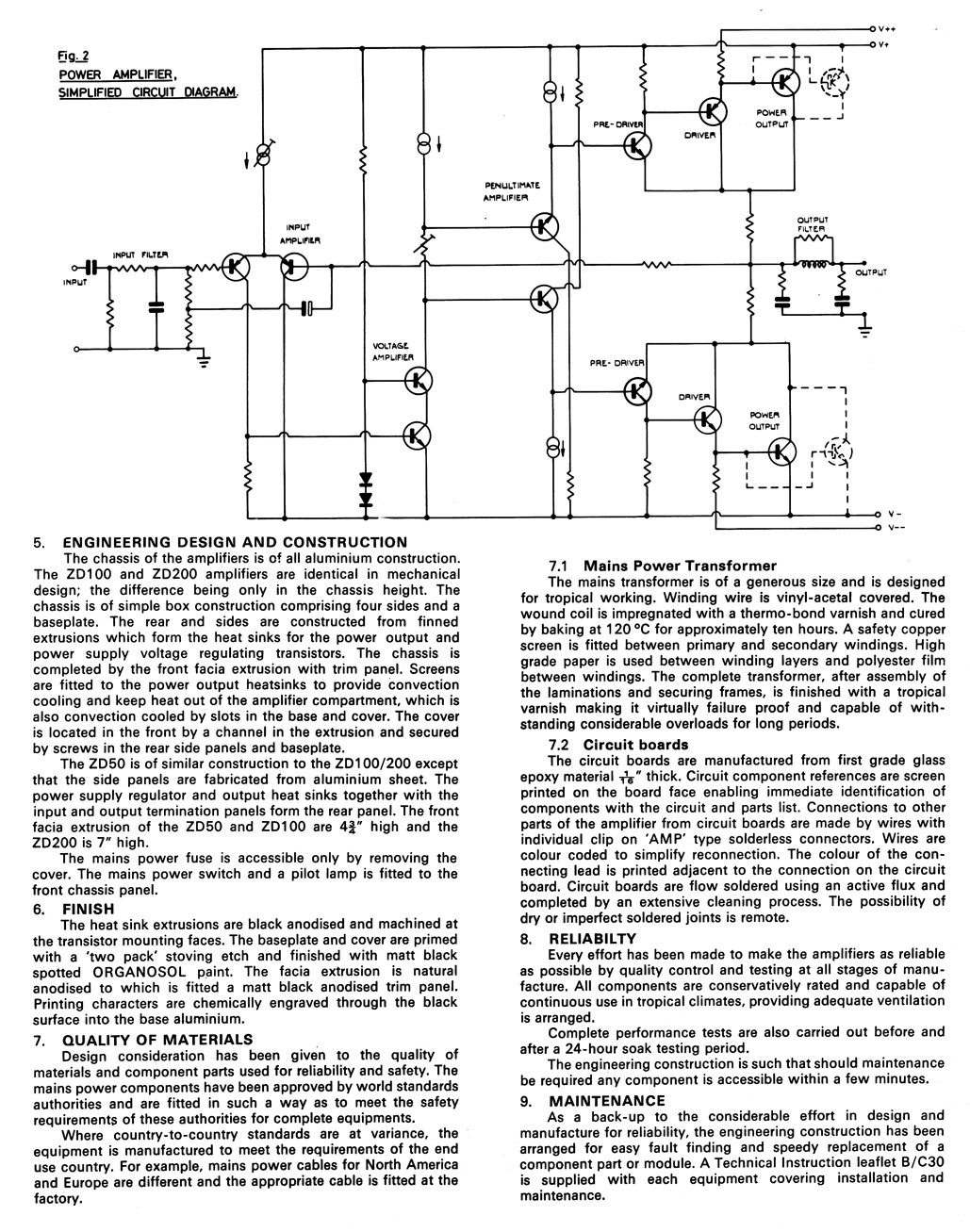
Buy the bookdear sir
i want to know how an amplifier works and want to know their function.by gainig knowledge i can draw new types of amplifier.thanks
>>i want to know how an amplifier works and want to know their
>>function.by gainig knowledge i can draw new types of amplifier.thanks
>Buy the book Or if budget is a problem,
Or if budget is a problem,
>just Google for amplifier theories
The best investment you can make is to buy these three books :
Horowitz and Hill's and
Self's on power amps,
Self's on small signal.
By the way, The Amplifier Institute.
needs an update for the sixth edition.
>>function.by gainig knowledge i can draw new types of amplifier.thanks
>Buy the book
>just Google for amplifier theories
The best investment you can make is to buy these three books :
Horowitz and Hill's and
Self's on power amps,
Self's on small signal.
By the way, The Amplifier Institute.
needs an update for the sixth edition.
Last edited:
>>i want to know how an amplifier works and want to know their
>>function.by gainig knowledge i can draw new types of amplifier.thanks
>Buy the bookOr if budget is a problem,
>just Google for amplifier theories
The best investment you can make is to buy three books :
Horowitz and Hill's and
Self's on power amps,
Self's on small signal.
By the way, The Amplifier Institute.
needs an update for the sixth edition.
I do not agree to that recommendation Forr. These books are great if you have a basic understanding of solid state circuits. But if you start from scratch you need a more basic text. Horowitz and Hill is really not for someone who 'wants to know how amplifiers work', and the others are only slightly better for this purpose.
jan
Douglas, so-called "TMC" is, in fact, two pole compensation applied about the second and output stage; this point should have been made in the book.
Further, on page 348 you state that amplifiers with two pole compensation are conditionally stable. This need not be the case if the system is properly designed.
Further, on page 348 you state that amplifiers with two pole compensation are conditionally stable. This need not be the case if the system is properly designed.
- Status
- This old topic is closed. If you want to reopen this topic, contact a moderator using the "Report Post" button.
- Home
- Amplifiers
- Solid State
- Audio Power Amplifier Design book- Douglas Self wants your opinions
